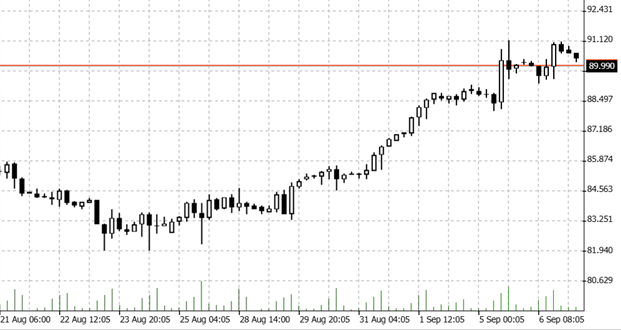

07.09.2023 – Moscow and Riyadh shock the market with statements on production cuts. The oil price picks up. Another factor for the bulls is the war in Ukraine.
On Tuesday, the oil price had climbed sharply to the north, here the four-hour chart of Brent. In the meantime, the price of the European variety to the highest level since last November, before a reset was pending. Nevertheless, fears of stagflation immediately circulated on the stock exchange floor: stifled economy with high inflation.

Source: Bernstein Bank GmbH
The background: At the beginning of July, the latest round of announcements of production cuts by the oil states had begun. And on Tuesday, Russia and Saudi Arabia announced that they mean business: Both want to extend production cuts until the end of 2023, taking 1.3 million barrels per day off the market. With this, the two oil exporters shocked the market: “It was absolutely a surprise,” judged Nadia Martin Wiggen, director at the commodity-focused hedge fund Svelland Capital. She added: “When we look toward the start of next year after these cuts, we’re going to see OECD commercial stock levels at lows we haven’t seen except in very big years.”
Goldman responds
Goldman Sachs commented that there are now upside risks to its own oil price forecast. So far, the Goldmen have assumed a price for Brent of $86 for December 2023 and $93 for December 2024. The upside risk to the forecast at the end of this year is $2 per barrel, he said. If nine OPEC-plus countries did not reverse half of the production cut announced in April in January 2024, the upside risk would be $107 per barrel, he said. However, oil countries are unlikely to target prices well above $100 per barrel. The reasons for this: a possible reaction from the U.S. fracking industry and the high political importance of the price of gasoline in the United States.
According to the “Frankfurter Allgemeine Zeitung”, the Landesbank Baden-Württemberg continues to see a price of 80 dollars per barrel for the North Sea variety Brent by the end of the year. The oil states could also roll back production cuts if demand is weak.
USA and Ukraine
But: Another bullish factor was reported yesterday by the American Petroleum Institute. According to the API, inventories fell by 5.2 million barrels, compared with 2.1 million barrels expected.Then there is an issue with petroleum that has just been pointed out by the brilliant Institute for the Studies of War: Apparently, the Russian defense industry cannot produce enough tires for the army. The worn-out tires are likely to make it difficult to move forward in the coming fall and winter in rain, slush and snow.
We think Moscow will probably take countermeasures and buy more tires through its allies North Korea and China. Even if Ukraine uses newer equipment, winter tires are likely to be in demand here as well. Both are likely to be felt on the global oil market.
We are curious to see how the oil price will develop and whether the world’s central banks will not counter the expected energy inflation in winter with higher interest rates. Whether long or short – we wish you successful trades and investments!
_______________________________________________________________________________________________________________________________________________
The content of this publication is for general information purposes only. In this context, it is neither an individual investment recommendation or advice nor an offer to purchase or sell securities or other financial products. The content in question and all the information contained therein do not in any way replace individual investor- or investment-oriented advice. No reliable forecast or indication for the future is possible with respect to any presentation or information on the present or past performance of the relevant underlying assets. All information and data presented in this publication are based on reliable sources. However, Bernstein Bank does not guarantee that the information and data contained in this publication is up-to-date, correct and complete. Securities traded on the financial markets are subject to price fluctuations. A contract for difference (CFD) is also a financial instrument with leverage effect. Against this backdrop, CFD trading involves a high risk up to the point of total loss and may not be suitable for all investors. Therefore, make sure that you have fully understood all the correlating risks. If necessary, ask for independent advice. CFDs are complex instruments and are associated with the high risk of losing money quickly because of the leverage effect. 68% of retail investor accounts lose money trading CFD with this provider. You should consider whether you understand how CFD work and whether you can afford to take the high risk of losing your money.7
